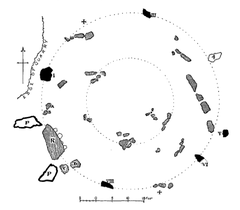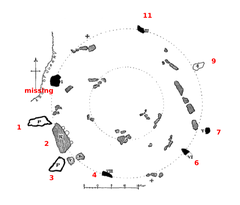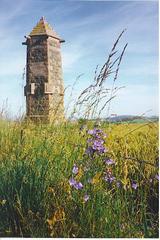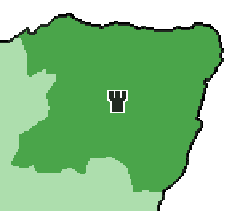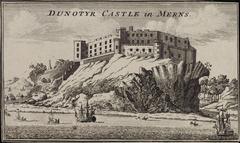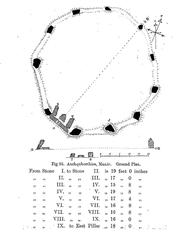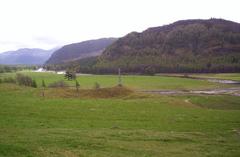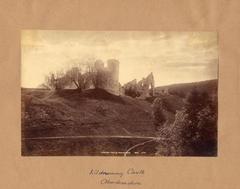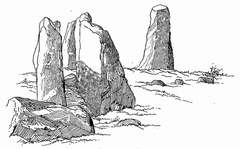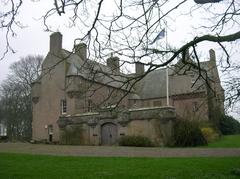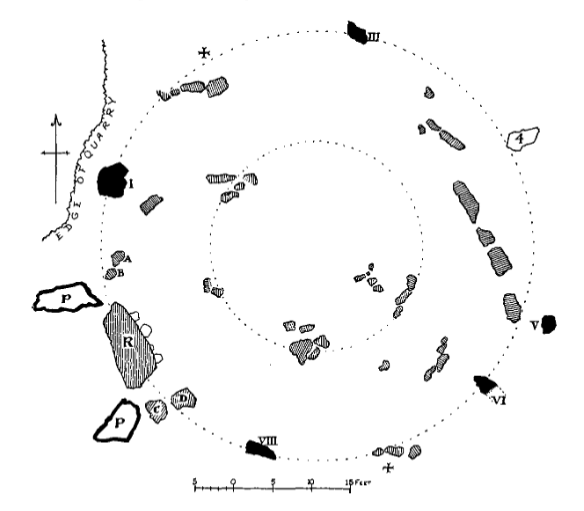
Visiting Tomnaverie Stone Circle, Ballater, United Kingdom: The Complete Guide
Date: 15/06/2025
Introduction
Perched on a granite hill near the picturesque villages of Ballater and Tarland in Aberdeenshire, Scotland, Tomnaverie Stone Circle stands as an exceptional example of a recumbent stone circle—one of the most intriguing prehistoric monuments in the United Kingdom. Dating to around 2500 BCE, Tomnaverie offers a glimpse into the sophisticated ritual, social, and astronomical practices of Scotland’s late Neolithic and Bronze Age communities. Its distinctive architecture, panoramic views, and enduring mystery make Tomnaverie a must-visit site for history enthusiasts, archaeology buffs, and those seeking to connect with Scotland’s ancient past.
This comprehensive guide provides everything you need to know about Tomnaverie Stone Circle: its history and construction, cultural and astronomical significance, visitor information including hours, accessibility, and travel tips, as well as suggestions for nearby attractions. Whether you are planning your first visit or deepening your knowledge of Aberdeenshire’s ancient sites, this guide will help you make the most of your experience.
For official updates and further research, consult resources such as Historic Environment Scotland and Megalithic Portal.
Table of Contents
- Introduction
- Historical Background
- Ritual, Astronomical, and Social Significance
- Archaeological Investigations and Restoration
- Visiting Tomnaverie Stone Circle: Practical Information
- FAQ
- Conclusion and Final Tips
- References
Historical Background
Origins and Construction
Tomnaverie is one of fewer than 100 recumbent stone circles built in northeast Scotland during the late Neolithic period. Characterized by a massive horizontal “recumbent” stone set on the southern arc of the circle and flanked by the tallest uprights, this monument type reflects a unique architectural tradition. The circle was constructed around 2500 BCE, during an era of increased monument-building linked to cosmological beliefs and social transformation (Historic Environment Scotland).
Architectural Features
Tomnaverie originally comprised thirteen granite stones set in a ring about 17–18 meters in diameter, with eleven stones standing today thanks to restoration efforts. The recumbent stone, measuring over 3 meters in length and weighing approximately 6.5 tons, is flanked by two imposing upright stones. A polygonal ring cairn, roughly 15 meters across, lies within the circle, edged by surviving kerbstones that turn outward to meet the recumbent setting. The stones are carefully graded in height, with the tallest beside the recumbent and the shortest opposite, enhancing the monument’s visual impact.
Notably, the recumbent stone and some others bear prehistoric cup marks, suggesting ritual significance.
Construction Sequence and Use
Excavations indicate that ritual burning or land clearance activities occurred before the stones were erected. The cairn appears to predate the stone circle, with the latter constructed to accommodate the earlier structure. Artefacts such as pottery fragments, flint tools, and cremated human remains suggest the site was used for ceremonies and funerary practices, with continued adaptation well into the Bronze Age.
Ritual, Astronomical, and Social Significance
Recumbent stone circles like Tomnaverie are believed to have served as focal points for ritual gatherings, processions, and rites of passage. The site’s elevated position offers sweeping views of the Howe of Cromar, Lochnagar, Morven, and the Cairngorms, situating the monument in a landscape of enduring cultural resonance.
Tomnaverie is oriented southwest, framing the distant Lochnagar peak. This alignment has led to theories about its use for astronomical observations, particularly lunar events such as the midsummer full moon’s setting over the recumbent stone. The choice of quartz-rich granite may have been intentional to reflect moonlight, creating dramatic visual effects during lunar cycles (Stones of Wonder).
The construction and use of Tomnaverie required significant communal effort, reflecting complex social organization and a shared cosmological worldview.
Archaeological Investigations and Restoration
The first excavation at Tomnaverie took place in 1929, revealing the inner cairn and confirming the monument’s prehistoric origins. By the late 20th century, quarrying and neglect had damaged the site; only four stones remained standing. In 1999–2000, a major archaeological project led by Professor Richard Bradley clarified the sequence of construction and enabled restoration. Displaced stones were re-erected in their original positions, returning Tomnaverie to near its ancient form (Megalithic Portal).
Geophysical surveys have identified additional prehistoric features in the vicinity, enriching understanding of this wider ritual landscape (Out About Scotland).
Visiting Tomnaverie Stone Circle: Practical Information
Hours and Tickets
Tomnaverie Stone Circle is open year-round, with access recommended during daylight hours for safety and the best experience. There are no entry fees or tickets required (Historic Environment Scotland).
Getting There and Accessibility
- Location: Approximately 1 km south of Tarland and 5 km southeast of Ballater, in Aberdeenshire.
- Car: The site is easiest to reach by car, with a small dedicated car park off the B9094 road (Live Breathe Scotland).
- Public Transport: Very limited; driving is strongly recommended.
- Path: A well-maintained gravel path (about 300 meters) leads from the car park to the circle. The route is suitable for most visitors, though the incline may challenge some with limited mobility.
- Facilities: There are no toilets or refreshment facilities on site; amenities can be found in nearby Tarland or Ballater.
Visitor Tips and Guided Tours
- Best Time to Visit: Early morning or late afternoon for optimal lighting and fewer visitors.
- Clothing: Dress in layers and bring waterproofs; the exposed hilltop can be windy and wet.
- Footwear: Sturdy shoes are recommended due to the uneven, sometimes slippery path.
- Guided Tours: While not regular, some local operators include Tomnaverie in their itineraries.
- Photography: The panoramic setting and stone arrangements are ideal for photos; drone use must comply with Historic Environment Scotland’s policy.
Nearby Attractions
- Tarland: Local shops, cafés, and services.
- Ballater: Accommodation and dining options.
- Other Historic Sites: Explore Culsh Earth House, Kildrummy Castle, East Aquhorthies Stone Circle, and the Muir of Dinnet National Nature Reserve (Undiscovered Scotland).
Frequently Asked Questions (FAQ)
Q: Is there an entry fee?
A: No, the site is free to visit year-round.
Q: What are the opening hours?
A: The monument is open at all times, but daylight visits are advised.
Q: Is the site wheelchair accessible?
A: The path is accessible but has a moderate incline; some assistance may be required.
Q: Are there public toilets or refreshments?
A: No; use facilities in Tarland or Ballater before visiting.
Q: Can I fly a drone at Tomnaverie?
A: Yes, in accordance with official guidelines and respect for other visitors.
Conclusion and Final Tips
Tomnaverie Stone Circle is a remarkable testament to Scotland’s prehistoric ingenuity, social complexity, and deep engagement with the landscape and cosmos. Its distinctive recumbent stone, graded circle, and panoramic setting invite visitors to reflect on four millennia of human history. Thanks to careful restoration and ongoing conservation, Tomnaverie remains accessible for exploration and contemplation—free of charge and open year-round.
For an enhanced experience, use digital resources such as the Historic Scotland app and consider exploring related sites across Aberdeenshire. Plan your visit with weather and site conditions in mind, and embrace the opportunity to connect with one of Scotland’s most evocative ancient monuments.
Alt text: Tomnaverie Stone Circle, a Neolithic recumbent stone circle located in Aberdeenshire, Scotland.
Alt text: Map showing location of Tomnaverie Stone Circle near Ballater, Aberdeenshire.
Virtual Tour of Tomnaverie Stone Circle
For more about Aberdeenshire historical sites, visit our Aberdeenshire Heritage page and discover other fascinating Scottish monuments.
References and Further Reading
- Visiting Tomnaverie Stone Circle: History, Tickets, and Travel Tips in Aberdeenshire, 2024
- Historic Environment Scotland – Tomnaverie Stone Circle
- Megalithic Portal – Tomnaverie
- Live Breathe Scotland – Tomnaverie Stone Circle
- Out About Scotland – Muir of Dinnet
- Undiscovered Scotland – Tomnaverie Stone Circle
